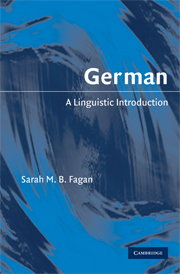Introduction
Published online by Cambridge University Press: 25 January 2010
Summary
German: speakers and geography
Standard German is spoken by approximately 95 million speakers worldwide (Gordon 2005). It is an official language in Germany, Austria, Switzerland, Luxembourg, and Liechtenstein. It is the national (sole official) language in Germany, Austria, and Liechtenstein; in Switzerland it is an official language along with French, Italian, and Rhaeto-Romansh; in Luxembourg it shares official status with French and Luxemburgish (Lëtzebuergesch), a Mosel Franconian dialect. German is also an official regional language in Belgium, Italy, and Denmark, and is spoken in a number of other countries, including the Czech Republic, Kazakhstan, Poland, and Paraguay.
Standard German is the variety of German that is described in grammars and dictionaries. It is the “official” form of the language; texts written in German typically follow the spelling and grammar norms of this variety of German. Standard German is the form that is typically used in school in German-speaking countries and the variety that is taught to non-native speakers studying German as a foreign language. Although non-standard varieties of German will also be treated here (German dialects, Foreign Worker German, etc.), Standard German is the variety that is the focus of this study. The chapters on the sounds of German, the structure of German words, the regularities of word order, and so on all deal with the standard language.
Objectives
This book aims to provide an introduction to the linguistic structure of Standard German that is rich in descriptive detail and grounded in modern linguistic theory.
- Type
- Chapter
- Information
- GermanA Linguistic Introduction, pp. 1 - 3Publisher: Cambridge University PressPrint publication year: 2009

